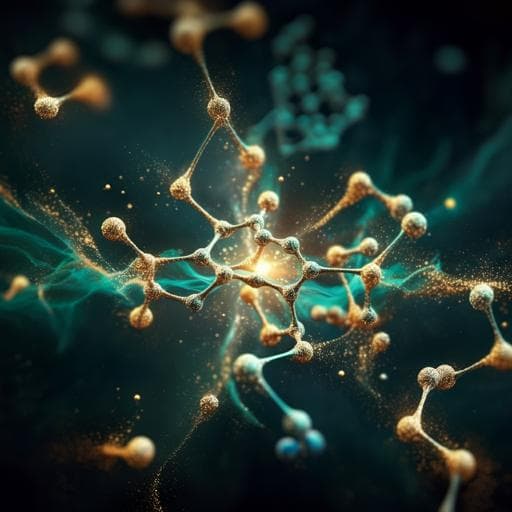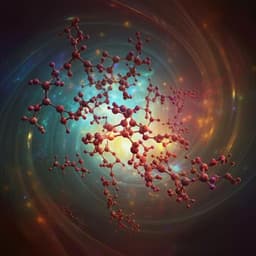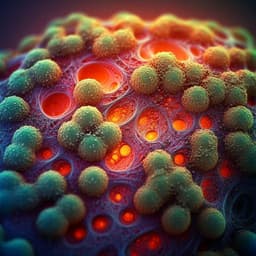
Chemistry
Catalytic asymmetric synthesis of carbocyclic C-nucleosides
S. Mishra, F. C. T. Modicom, et al.
Discover a groundbreaking method for synthesizing carbocyclic C-nucleosides that overcomes lengthy processes and poor modularity. Researchers Sourabh Mishra, Florian C. T. Modicom, Conor L. Dean, and Stephen P. Fletcher introduce an innovative asymmetric Suzuki-Miyaura reaction, enabling the formation of diverse enantiomerically enriched CC-Ns, including a unique carbocyclic derivative of Showdomycin.
~3 min • Beginner • English
Introduction
Nucleosides and their analogs are widely studied antiviral and anticancer agents, with several clinically used drugs such as Entecavir, Aristeromycin, Abacavir, Galidesivir, Remdesivir and Molnupiravir illustrating their impact. Carbocyclic nucleoside analogs exhibit enhanced flexibility, lipophilicity, and metabolic stability, contributing to broad antiviral activity. Traditional synthetic strategies to N- and C-nucleosides often rely on nucleophilic addition to carbohydrate-derived oxocarbenium ions and on constructing the carbocycle with subsequent nucleobase installation. While carbocyclic N-nucleosides are well explored, carbocyclic C-nucleosides (CC-Ns) are rare due to synthetic challenges. Existing methods are typically long and non-modular; for example, a Merck synthesis of a CC-N targeting Alzheimer’s disease required 17 steps from D-ribose. The purpose of this work is to develop a modular, catalytic, asymmetric approach to CC-Ns that forms the key C–C bond via an asymmetric Suzuki–Miyaura-type coupling of a racemic, pseudo-symmetric bicyclic allyl chloride with heteroaryl boronic acids, followed by elaboration of the cyclopentene core to ribose analogs by installing a 5′-hydroxymethyl group with full stereo- and regio-control. This approach aims to expand accessible CC-N chemical space and facilitate synthesis of diverse, potentially bioactive analogs.
Literature Review
Prior work has established numerous routes to N- and C-nucleosides and carbocyclic N-nucleosides, often leveraging nucleophilic additions to carbohydrate oxocarbenium ions and Pd-catalyzed allylic amination followed by late-stage nucleobase construction. However, CC-Ns remain underexplored due to lengthy, non-modular sequences and stereochemical complexity, exemplified by a 17-step synthesis from D-ribose for a Merck candidate. Asymmetric Suzuki–Miyaura couplings (SMC) have been developed for racemic allyl halides, including rhodium-catalyzed allylic arylation with arylboronic acids, with demonstrated enantio- and diastereoselectivity. Extending these methods to complex heteroaryl boronic acids is challenging because such nucleophiles can be unstable and can poison catalysts or undergo proto-deboronation; the 2-pyridyl motif is notably problematic in cross-coupling. Heterocycle-rich nucleobases (multiple heteroatoms) present additional compatibility issues in both cross-coupling and subsequent functionalizations. These challenges motivate either (i) direct use of complex nucleobase boronic acids (potentially high risk) or (ii) initial installation of simpler heterocycles followed by late-stage transformations to more elaborate nucleobases.
Methodology
Strategy overview: The core C–C bond is formed by a catalytic asymmetric Suzuki–Miyaura-type coupling between a racemic, pseudo-symmetric bicyclic allyl chloride (substrate 1) and heteroaryl boronic acids (2), to generate trisubstituted cyclopentenes (3) bearing three contiguous stereocenters set via desymmetrization. These intermediates are elaborated to carbocyclic ribose analogs by installing a 5′-hydroxymethyl group through a hydroborylation–Matteson homologation–oxidation sequence, followed by acetonide deprotection. Two routes to more complex CC-Ns are examined: (B) direct cross-coupling of complex nucleobase boronic acids and (C) late-stage modification of simpler heterocycles (e.g., furan) to build complex nucleobases.
Asymmetric SMC conditions: Typical reactions used [Rh(COD)(OH)]2 (2.5 mol%) with (S)-SegPhos (6 mol%) in THF/H2O (10 vol% water), aqueous CsOH (1.0 equiv), at 60 °C for 18 h, with boronic acid (2.0 equiv) and allylic chloride 1 (1.0 equiv). For some pyridyl-4-boronic acids, 50 °C was used; for dihalo-pyridines, room temperature (21 °C) improved outcomes. Simple benzene-derived nucleophiles and selected 2-halo-pyridyl boronic acids were effective. Complex heterocycles required screening; in one case (pyrrolo-triazine boronate 9e) higher catalyst loading ([Rh(COD)(OH)]2 5 mol%, (S)-SegPhos 12 mol%) enabled productive coupling.
Scope evaluation: Six-membered heterocycles (2-halo-pyridines) and five-membered heterocycles (furans, pyrroles) were examined. Pyridyl boronic acids with 2-halogen substituents moderated Lewis basicity and served as functional handles. Yields and enantioselectivities were measured; diastereoselectivity delivered single diastereomers of 3.
Installation of 5′-hydroxymethyl (hydroborylation–homologation–oxidation): Cyclopentenes 3 were subjected to Rh-catalyzed hydroboration with pinacol borane using [Rh(PPh3)3Cl] (2.5 mol%) and Cs2CO3 (1.0 equiv) in THF at 50 °C for 16 h to give secondary boronic ester 4 as a single isomer; Cs2CO3 suppressed undesired hydrogenation. Matteson homologation employed n-BuLi (2.5 equiv) and iodochloromethane (3.0 equiv) in THF (−78 °C to rt, 18 h) to provide primary boronic ester 5, followed by oxidation with H2O2/aq. NaOH in THF (0 °C to rt, 3 h) to give alcohol 6. The sequence was performed on up to 4 mmol scale for representative substrates (e.g., 6h, 6k). Final acetonide deprotection with AcOH/H2O (50 °C, 16 h) furnished CC-Ns 7.
Late-stage modification pathway (Strategy C): To access complex nucleobases from simpler heterocycles, furan-bearing 6h was protected (TBSOTf/imidazole, DMF, rt) and the furan was oxidatively cleaved using RuCl3 (10 mol%) and NaIO4 (EtOAc/MeCN/H2O, 60 °C) to carboxylic acid 12. From 12, the acid chloride (oxalyl chloride, DCM) was formed in situ and coupled with 1,2-diaminobenzene to give the amide, followed by AcOH/H2O cyclization and global deprotection to benzimidazole-derived CC-N 11.
Synthesis of a carbocyclic Showdomycin analog: Starting from pyrrole-bearing 3k (94% ee), hydroborylation–homologation–oxidation delivered 6k (62% over three steps). Alcohol protection (TBS), then Boc deprotection on the pyrrole afforded 14 (65% over two steps). Pyrrole oxidation with PCC and final TFA-mediated deprotection furnished carbocyclic Showdomycin analog 16 (53% over the last two steps).
Attempts with complex nucleobase boronic esters (Strategy B): Pyrrolo[2,1-f][1,2,4]triazine boronic esters were prepared via Ir-catalyzed C–H borylation ([Ir(COD)(OMe)]2/dtbpy, MTBE, 50 °C) yielding regioisomer mixtures for several targets (9a–c), but single isomers 9d–e were accessible (e.g., 9e 68% yield). Asymmetric SMC of 9e gave 3q (40% yield, 93% ee) with increased catalyst loading. Hydroborylation to 4q (63%) proceeded, but Matteson homologation failed, likely due to incompatibility with multiple ring nitrogens; oxidation and global TFA deprotection afforded triol 10 in 68% over two steps (overall ~43% from 3q).
Representative procedures are provided: general SMC, hydroborylation, homologation, oxidation, and deprotection conditions, including reagent quantities and workups.
Key Findings
- The asymmetric Suzuki–Miyaura-type coupling of a racemic bicyclic allyl chloride with heteroaryl boronic acids provides single-diastereomer cyclopentenes 3 in high yields and enantioselectivities across diverse heterocycles.
- Benchmark reactions:
• Phenylboronic acid: 3a in 90% yield, 95% ee.
• 2-halo-pyridyl boronic acids (selected): 3b (70% yield, 94% ee), 3c (90%, 92% ee), 3d (85%, 90% ee) at 50 °C, 3e (72%, 93% ee) at 50 °C, 3f (80%, 96% ee), 3g (32%, 85% ee).
• Five-membered heterocycles: 3h (furan, 80%, 97% ee), 3i (furan, 81%, 97% ee), 3j (pyrrole, 55%, 97% ee), 3k (pyrrole, 65%, 94% ee).
• More complex heterocycles: 3l (80%, 80% ee at 21 °C), 3m (98%, 80% ee at 21 °C), 3n (79%, 80% ee), 3o (48%, 94% ee), 3p (pyrimidine, 70%, 94% ee).
- Scale-up: 3h and 3k were prepared on 5 mmol scale (~1 g) with consistent yield and ee.
- An efficient, stereocontrolled 3-step hydroborylation–homologation–oxidation sequence installed the 5′-CH2OH group with complete regio- and stereocontrol, delivering alcohols 6 in useful yields: e.g., 6a (71% over 3 steps), 6b (34%), 6c (71%), 6e (49%), 6h (53%), 6j (57%), 6k (62%), 6l (45%).
- Acetonide deprotection furnished CC-Ns: 7a (93%), 7b (91%), 7c (88%), 7e (76%), 7h (70%), 7i (62%).
- Complex nucleobase coupling proof-of-concept: pyrrolo-triazine boronate 9e coupled to give 3q (40% yield, 93% ee) with doubled catalyst loading; hydroborylation succeeded (63%), but homologation failed; oxidation and deprotection afforded triol 10 (68% over 2 steps; ~43% overall from 3q).
- Late-stage modification (Strategy C): Furan oxidative cleavage gave carboxylic acid 12 (65% over 2 steps from protected 6h). Conversion to a benzimidazole CC-N (11) proceeded in 52% yield from 12, demonstrating modular access to more complex nucleobases.
- A carbocyclic analog of Showdomycin (16) was synthesized from 3k (94% ee) via hydroborylation–homologation–oxidation to 6k (62% over 3 steps), protection/deprotection to 14 (65% over 2 steps), then PCC oxidation and TFA deprotection (53% over last 2 steps).
Discussion
The study addresses the central challenge of modular, enantioselective synthesis of carbocyclic C-nucleosides by leveraging a desymmetrizing rhodium-catalyzed SMC of racemic allyl chlorides with heteroaryl boronic acids. The methodology consistently delivers high enantioselectivity and diastereoselectivity across a range of heterocycles, particularly with 2-halo-pyridyl, furan, and pyrrole boronic acids, establishing a general entry to enantioenriched cyclopentenes that can be elaborated to CC-Ns. The subsequent hydroborylation–Matteson homologation–oxidation sequence installs the 5′-hydroxymethyl group with full regio- and stereocontrol, enabling access to carbocyclic ribose analogs.
Attempts to directly incorporate complex nucleobase boronic acids (Strategy B) underscored key limitations: instability of complex boronic acids (e.g., protodeboronation), catalyst incompatibilities, and downstream functionalization challenges (e.g., homologation failure for pyrrolo-triazine). In contrast, the late-stage modification strategy (Strategy C) proved robust, transforming simpler heterocycles (e.g., furan) into carboxylic acids that serve as versatile platforms for constructing complex nucleobases, as shown by the synthesis of a benzimidazole CC-N and a carbocyclic Showdomycin analog. These results highlight the modularity and practicality of Strategy C for generating libraries of complex CC-Ns and demonstrate scalability suitable for multi-step sequences.
Conclusion
This work introduces modular, catalytic asymmetric routes to carbocyclic C-nucleosides. A rhodium-catalyzed asymmetric Suzuki–Miyaura-type coupling desymmetrizes a racemic bicyclic allyl chloride to deliver enantioenriched cyclopentenes, which are converted to ribose analogs via a stereocontrolled hydroborylation–homologation–oxidation sequence. The method tolerates a variety of heterocycles (2-halo-pyridines, furans, pyrroles) and scales to gram quantities. While direct incorporation of complex nucleobase boronic acids is possible in select cases, it is hampered by instability and incompatibility issues. A late-stage modification approach from simpler heterocycles provides a practical pathway to complex CC-Ns, demonstrated by the synthesis of a benzimidazole CC-N and a carbocyclic Showdomycin analog.
Future directions include: developing more stable/compatible complex boronates (e.g., alternative protecting groups, boronate classes), refining catalysts/conditions to better accommodate multi-heteroatom nucleobases, exploring homologation protocols compatible with nitrogen-rich frameworks, and expanding late-stage diversification manifolds from intermediates like carboxylic acid 12 to rapidly access diverse, bioactive CC-N scaffolds.
Limitations
- Complex heteroaryl boronic acids (particularly multi-heteroatom nucleobases) are difficult to prepare, often unstable, and prone to protodeboronation, limiting direct SMC applicability.
- Some heterocycles (e.g., certain chloropyridines and cyano-pyrrole derivatives) decomposed under hydroborylation conditions.
- Matteson homologation was incompatible with nitrogen-rich substrates (e.g., pyrrolo-triazine intermediate 4q), preventing installation of the 5′-CH2OH group in those cases.
- Enantioselectivity decreased for some more complex or dihalo-substituted pyridines (e.g., 80% ee), and yields varied significantly for ortho-substituted systems.
- Late-stage modification adds steps relative to direct coupling and may require substrate-specific optimization for sensitive functionalities.
Related Publications
Explore these studies to deepen your understanding of the subject.







